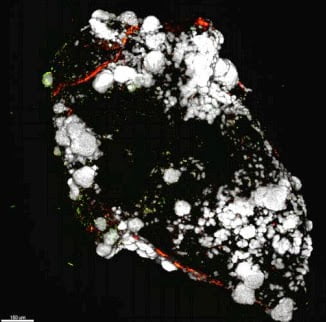Most of the 600 strains of periodontal biofilms DNA sequenced by the National Institutes of Health are now in this series of programs. Most strains of lyme disease borrelia are included. Nanobacteria and other biofilms associated with Altzheimers can be found here. Biofilms are associated with all major disease categories. There is even a new program targets abdominal fat.
Recent research has focused on biofilm involvement in tumors. All tumors (benign and malignant) are infected with biofilms. The relationship of causation of tumors by biofilms is still being researched. It appears that many so-called Rife frequencies are really components of biofilms.
There is extensive academic research on biofilms. See Montana State University Center for Biofilm Engineering for the basics, as well as access to papers from dozens of conferences. For example, most people have biofilms forming calcification in their joints and articles. Here is a photo of such a biofilm on a grain of sand:
These biofioms are not doing your heart any good.
Most bacteria infections today are antibiotic resistant biofilms. While over 600 species of these biofilms have been DNA sequenced for periodontal disease, these gum infections are the tip of the iceberg. A huge amount of illness from joint problems to wound infections to heart disease are caused by biofilms.
During the past two years, intensive research at the Frequency Research Foundation has developed frequency sequences for about 400 biofilms. A notable finding is that radical reduction in blood pressure can be achieved by running the appropriate borrelia biofilm programs for infected individuals. All people exposed to lyme disease will need them.
There are over 600 species of periodontal biofilms that have been DNA sequenced. During the past two years, the Frequency Research Foundation has done detailed analysis of frequencies for over 300 biofilm infections. This is the most extensive research effort since development of the lyme disease frequency sets and has involved daily analysis and update of biofilm frequencies from September 2011 until July 2013. As a result these data are the most comprehensive biofilm frequency sets available.
Some are based on the lyme borellia spirochete and cause elevated blood pressure. Others are directly related to mortality from heart disease. See:
All biofilms can go systemic in the body and cause a wide variety of symptoms and disease outcomes. For the first time it is possible to work on getting rid of the root cause of gum disease and other persistent infections.
Frequencies are published as a set of over a dozen F165 program files. It is best to work on one biofilm frequency set at a time as one clinician has noted that use of these frequencies is analagous to tearing up the floorboards in your house. You never know what you are going to find underneath.
Frequencies are available to subscribers for research purposes at subscribers.frequencyfoundation.com.

